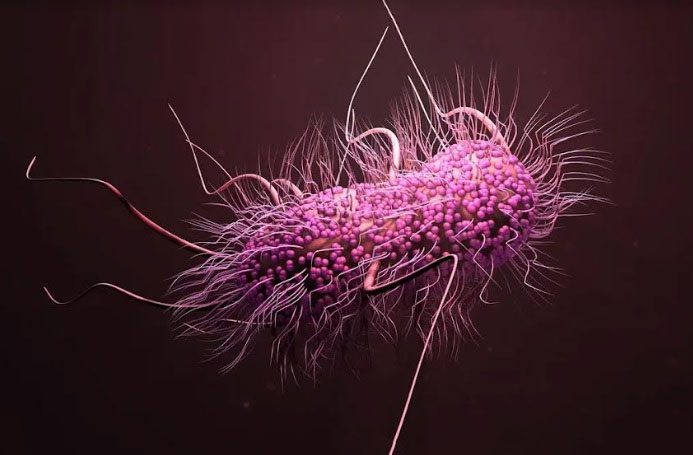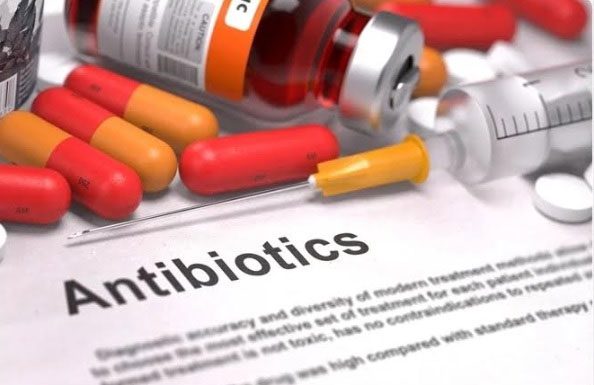Scientists have recently developed a new “weapon” against antibiotic-resistant superbugs – a type of antibiotic capable of changing its shape.
According to a study published in the Proceedings of the National Academy of Sciences on April 3, researchers have tested a self-modifying antibiotic in Galleria mellonella larvae, a common animal model used to evaluate the effectiveness of antibiotics in research.

Graphic image of an antibiotic-resistant superbug. (Photo: Live Science)
To create this new antibiotic, researchers employed the “click chemistry” method. Click chemistry is a type of reaction where small molecules bond together to form larger ones, reacting in a way that is irreversible. This method has been applied in DNA sequencing technologies and materials science, offering high yields and cleanliness, with minimal unwanted by-products.
Under the guidance of K. Barry Sharpless, one of the “fathers” of click chemistry and Nobel Prize winner in Chemistry, the lead author of the study, Professor John Moses from Cold Spring Harbor Laboratory (CSHL) in New York, successfully created a type of antibiotic that can alter the arrangement of atoms and change shape.
Professor Moses was inspired to develop a shape-shifting antibiotic while observing how tanks operate during military training. With their rotating turrets and agile movements, tanks can quickly respond to potential threats.
The new antibiotic essentially combines an existing antibiotic called vancomycin with bullvalene molecules. According to CSHL’s findings, bullvalene, serving as the “core” of the antibiotic, can easily swap the positions of atoms and arrange them into over a million different configurations. Meanwhile, the two ends of vancomycin attach to the bullvalene “core.”
Dr. Josh Homer, a co-author of the new study, describes the bullvalene “core” as functioning like a Rubik’s Cube that can change shape. “When two vancomycin units are attached to the Rubik’s Cube in the center, these vancomycin units can freely move around, protecting the outer space,” explains Josh.
Vancomycin is a potent antibiotic used to treat severe infections caused by Gram-positive bacteria. To eliminate these bacteria, the antibiotic binds to the bacterial cell wall and weakens it, causing the contents within the bacterial cell to leak out, ultimately leading to bacterial death.
Unfortunately, many bacteria have developed resistance to vancomycin, including vancomycin-resistant Enterococcus (VRE). According to the Centers for Disease Control and Prevention (CDC), in 2017, there were approximately 54,500 hospital infections and an estimated 5,400 deaths due to VRE.

The World Health Organization (WHO) ranks antibiotic resistance among the top 10 public health threats.
In the new study, when untreated Galleria mellonella larvae were infected with VRE, the mortality rate within one week was 90%. After receiving a standard dose of vancomycin, the survival rate after one week increased from 10% to 40%. Finally, when treated with the new self-modifying antibiotic, the survival rate rose to 70%.
Researchers noted that compared to standard vancomycin, the self-modifying antibiotic can generate multiple tools to eliminate bacteria.
Professor Moses explained, “We found that the self-modifying antibiotic operates through a mechanism related to reacting with a key enzyme in the cell called MurJ. This enzyme transports energy from inside the cell to the cell wall, aiding the bacteria’s reproduction, leading to more severe infections.”
Notably, according to the research team’s analysis, the shape-shifting antibiotic does not cause VRE bacteria to become resistant. Typically, prolonged exposure to antibiotics helps bacteria select new resistance mechanisms, thereby enhancing their survival chances.
With the self-modifying shape mechanism, the new antibiotic can discover the optimal configuration to bind to the bacterial cell wall, forming a “trap” so that they cannot escape.
According to Professor Moses, although this new research is still in its early stages and has not yet been tested on humans, and its efficacy still requires study, one thing is certain: due to the bacteria never having encountered shape-shifting antibiotics before, these drugs will cause some level of disruption in bacterial functioning.
In the United States alone, drug-resistant bacteria and fungi infect nearly 3 million people each year and kill about 35,000. Antibiotics are essential and effective, but in recent years, excessive misuse has led to some bacteria developing drug resistance. Infectious diseases have become very difficult to treat.
This issue is even more serious in developing countries, where the incidence of infectious diseases is high and access to antibiotics is often limited. The World Health Organization (WHO) has identified antibiotic resistance as one of the top 10 global public health threats.
Professor Moses concluded that with click chemistry, researchers can create countless new drugs. These “weapons” against bacteria will be key to the survival and evolution of humanity.




















































